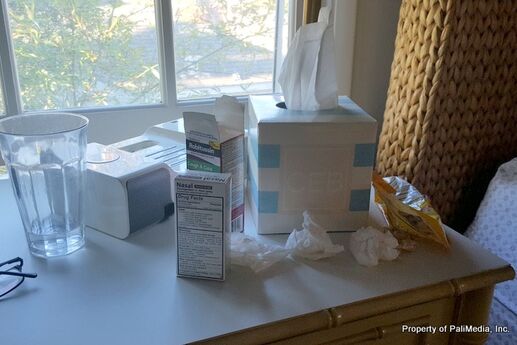Keep Houseguests Healthy and Happy
This year, when you're hosting parties and relatives during the holidays, there's an extra challenge to add to the mix: the risk of spreading cold and flu germs. While we all love to celebrate with friends, family and co-workers, it's easy for germs to crash the party.
Luckily, you can be a gracious host and keep everyone healthy, says etiquette expert Anna Post, great-great-granddaughter of Emily Post, the American author on etiquette. "It's always important to have good manners, but it's especially important during cold and flu season," she says
Post has some valuable advice for how to handle six of the season's most common germ-spreading scenarios. Follow her lead, and no one will leave your home with hurt feelings -- or the flu.
Scenario No. 1: Your friends arrive for a long weekend, and their child regularly sneezes without covering her mouth.
It's not your place to correct someone else's child, says Post. It's better to speak to the parent -- be clear and calm, as you're more likely to offend if you sound upset. Make it easy on your guests by saying, "I know we're all extra-worried about the flu this season. I'd be happy to leave a stool in the kitchen so the kids can wash their hands." Their daughter might even be excited to wash her hands like a grown-up. Finally, you could offer to teach her a clean-hands trick, but once again, make your tone gracious:"My kids love this trick of sneezing into their sleeve. May I teach it to Sara?”
Scenario No. 2: At this year's holiday potluck, people will want to shake hands when they arrive, but you don't want to encourage the spread of germs.
It's OK not to shake hands as long as you convey a warm welcome with your words and body language," says Post. She recommends tailoring the greeting to the person:
Close friends and loves ones: Give a hug.
- Acquaintances: Give a welcoming smile but keep your hands to yourself as you say, "It's so great to see you!”
- Co-workers: It's best to shake hands with colleagues. Just slip away to wash your hands once greetings are over.
Scenario No. 3: During a weeklong visit to your home, a relative comes down with a cold.
The most important thing is not to make her feel like a pariah, says Post. "She's not suddenly persona non grata just because she got sick." Tell her how sorry you are that she is feeling under the weather. She may decide to leave early, but if not, help her feel as comfortable as possible in your home. Set her up in a cozy bedroom that is quiet and away from others so she can get plenty of rest. (This also helps keep germs from spreading.) Set up a TV in the room and bring her some books to keep her occupied. Finally, go beyond asking what she needs, because she may be embarrassed to make requests, says Post. Offer to bring her some tea, draw her a hot bath, or run to the drugstore for medicine.
Scenario No. 4: You're playing games after a holiday dinner, and a friend coughs on the Wii remote and then hands it to you.
There are two appropriate responses, says Post. If the cougher isn't overly sensitive, go the direct route. Jokingly say (with a smile in your voice),"John, that's gross -- go clean that thing up!" If you're not comfortable being so blunt, try a more diplomatic approach. Simply take the remote as you say, "With the flu going around, let me just wipe this thing down.”
Scenario No. 5: You host a holiday happy hour at your home for your co-workers. One of them starts helping prepare appetizers but doesn't wash her hands before touching the food.
As hostess, it's your responsibility to speak up for the well-being of all your guests. That said, no one likes to be corrected, so it's important to speak gently. "When we're worried or stressed, we often forget that tone of voice makes all the difference. You need to be direct but also kind," says Post. Smile at your friend and nonchalantly say, "Oh, Kate, since it's cold and flu season, do you mind washing up? We just want to be extra-careful. There's some soap at the sink."
Scenario No. 6: It's two hours before your annual holiday cookie swap, and you notice the first signs of the flu. You don't want to let everyone down by canceling, but you don't want to get anyone sick either.
Call a close friend who's coming to your party and ask her to step in as hostess. You could say, "Jen, I think I'm coming down with something. I know this is a lot to ask, but everything is all ready, and I was hoping you could play hostess. I'll stay upstairs, but I want everyone to enjoy themselves.”
If you're too sick to have people in your home, ask a neighbor who is invited if she could hold the party at her house. Say, "Pam, I know this is last minute, and I'm so sorry. But I've got the flu and don't want to get anyone sick. Could we redirect to your place?" If she agrees, ask her to help you call the other guests to spread the word, and have your husband answer the door for any you can't reach. All he has to say is, "We're so sorry -- we tried to reach you. But my wife is sick, and we don't want to pass it along, so the party's next door."
If you don't have a friend who can host, then you must call your guests and cancel, says Post. "It's unfortunate to cancel last-minute, but it's better than causing your friends to get sick.”
Photo by Zohre Nemati on Unsplash
Like this article? Get more by following us on Facebook at Beauty & Confidence.






